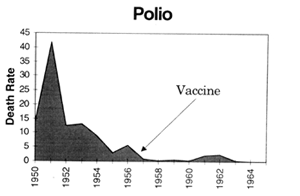PHILADELPHIA (AP) — After their 2-year-old son died of untreated pneumonia in 2009, faith-healing advocates Herbert and Catherine Schaible promised a judge they would not let another sick child go without medical care. But now they've lost an 8-month-old to what a prosecutor called "eerily similar" circumstances. And instead of another involuntary manslaughter charge, they're now charged with third-degree murder.
"We believe in divine healing, that Jesus shed blood for our healing and that he died on the cross to break the devil's power," Herbert Schaible, 44, told Philadelphia homicide detectives after their ninth child, Brandon, died in April. Medicine, he said, "is against our religious beliefs."
The Schaibles were ordered held without bail Friday, two days after their arrest, although defense lawyers argued that they are neither a flight risk nor a danger to the community.
"He is incarcerated because of his faith," said lawyer Bobby Hoof, who described client Herbert Schaible's mindset as resolute.
"He's strong willed," Hoof said. "(Yet) he's mourning this son. He's hurting as any dad would."
The only people theoretically at risk are the couple's seven surviving children, who are now in foster care, the lawyers said.
A judge acknowledged that the couple had never missed a court date in the first case but said he worried that might change amid the more serious charges. And he feared they may have supporters who would harbor them.
"Throughout this country ... there are churches like the Schaibles' whose members and leaders probably don't think they did anything wrong and might be willing — to paraphrase the Schaibles' pastor — to put their interpretation of God's will above the law," Common Pleas Judge Benjamin Lerner said.
About a dozen children die each year in the U.S. when parents turn to faith healing instead of medicine, typically from highly treatable problems, said Shawn Francis Peters, a University of Wisconsin lecturer who has studied faith-healing deaths.
In Oregon, four couples from a faith-healing church have been prosecuted, the most recent in 2011 when a couple was sentenced to more than six years in prison for manslaughter in the death of their newborn son.
The state legislature that year removed faith healing as a defense to murder charges. Members of the Followers of Christ have consistently refused to speak with journalists.
Defense lawyer Mark Cogan declined to comment Friday on whether the legal actions have changed the practice of any church members. Some testified at the 2011 trial that they do get medical care.
At the Schaibles' sentencing in February 2011 in their son Kent's death, they agreed to follow terms of the 10-year probation, which included an order to get their children regular checkups and sick visits as needed. Catherine Schaible, 43, let her husband speak for her and never addressed the judge.
"It's very clear that the law says that religious freedom is trumped by the safety of a child," Common Pleas Judge Carolyn Engel Temin explained.
But a transcript of a later probation hearing that year shows probation officers were confused by their mandate to oversee the required medical care and felt powerless to carry it out. The family was not being monitored by child-welfare workers, who are more accustomed to dealing with medical compliance.
"I think that we all on the jury thought that it would not happen again, that whatever social and legal institutions needed to be involved in their situation would just take over ... and that the mandated visits would be robust enough that they would not be able to do this again," Vincent Bertolini, a former college professor who served as jury foreman at the Schaibles' first trial, said Friday.
That jury convicted the couple of involuntary manslaughter and child endangerment.
Like other cases Peters has studied, the Schaibles belong to a small, insular circle of believers. Both are third-generation members and former teachers at their fundamentalist Christian church, the First Century Gospel Church in northeast Philadelphia.
Their pastor, Nelson Clark, has said the Schaibles lost their sons because of a "spiritual lack" in their lives and insisted they would not seek medical care even if another child appeared near death. He did not return phone messages this month, but he told The Associated Press in 2011 that his church is not a cult, and he faulted officials for trying to force his members into "the flawed medical system," which he blamed for 100,000 deaths a year.
"These are people who have been brought up in these communities; their beliefs are reinforced every day," Peters said. "They're not trained intellectually to question these doctrines, where the rest of us might engage in critical inquiry, weighing the benefits of medicine versus the benefits of prayer."
A handful of families, including one in western Pennsylvania, have lost two children after attempts at faith healing, according to Peters, who wrote "When Prayer Fails: Faith Healing, Children and the Law."
Peters isn't sure that courts have the means to prevent the problem, since such people don't fear legal punishment, only Judgment Day. Some believe death "is a good outcome," given their belief in the afterlife, he said.
"They don't want to harm their children. They're just in this particularly narrow — and very, very dangerous — way misguided about the potential of medical science," he said.
He believes that "empathetic" intervention, through dialogue between church and public health educators, could help some "get to a point where they allow their beliefs and practices to evolve."
But there's a risk that could backfire, and drive these communities further underground, he said.
For the Schaibles, a third-degree murder conviction could bring seven to 14 years in prison or more.
Said Assistant District Attorney Joanne Pescatore: "Somebody is dead now as a result of what they did — or didn't do."


